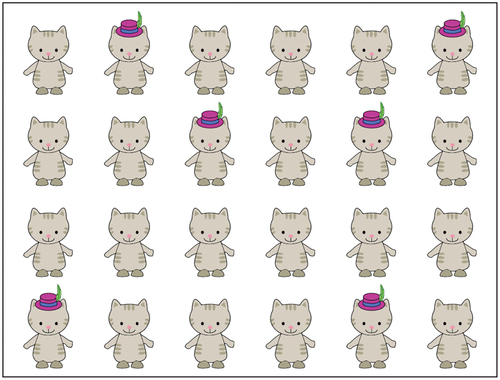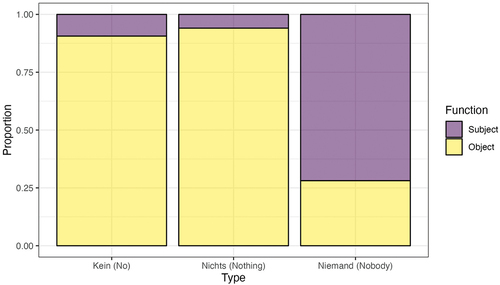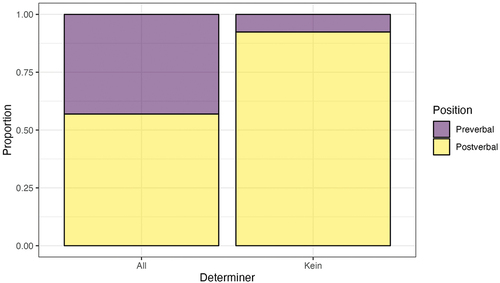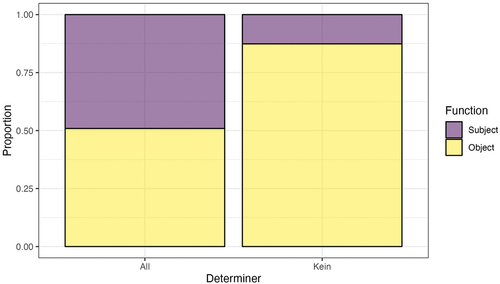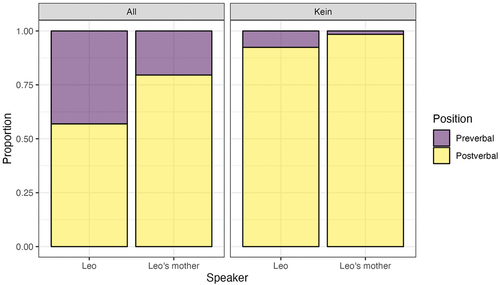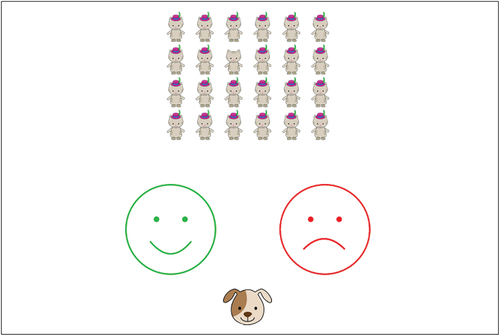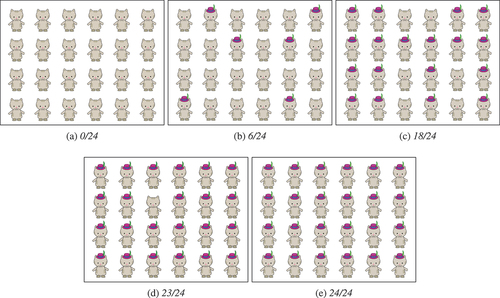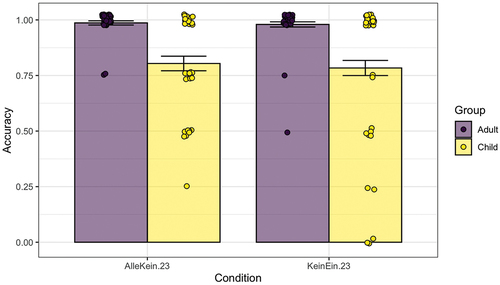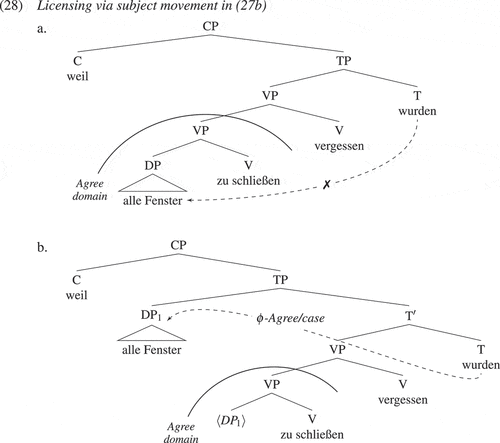 ?Mathematical formulae have been encoded as MathML and are displayed in this HTML version using MathJax in order to improve their display. Uncheck the box to turn MathJax off. This feature requires Javascript. Click on a formula to zoom.
?Mathematical formulae have been encoded as MathML and are displayed in this HTML version using MathJax in order to improve their display. Uncheck the box to turn MathJax off. This feature requires Javascript. Click on a formula to zoom.ABSTRACT
In this article, we present converging results from three studies investigating children’s production or comprehension of the negative indefinite kein in German. An elicited production study found that 3- to 6-year-old children and adults exhibit different patterns with respect to the production of kein: children, but not adults, exhibit an asymmetry with respect to the position where they produce negative indefinites, in that they use negative indefinites more frequently in object position than in subject position. A corpus study investigating spontaneous speech replicated this asymmetry for children but this time found it also present for adults. Finally, the asymmetry is corroborated by a comprehension study indicating a processing cost for negative indefinite subjects relative to negative indefinite objects. We argue that these patterns are most straightforwardly captured by an explanation that assumes the decomposition approach to the German negative indefinite kein: rather than a single semantic unit (i.e. negative quantifier), kein is decomposed into a negative part and an indefinite part.
1. Introduction
Human languages are able to express the existence and nonexistence of an entity, as English examples in (1a) and (1b) show.
Although all languages have the ability to build such sentences, their grammatical properties sometimes vary between languages. For example, though the grammatical features of the German and Romanian variants of the existence sentences in (2a) and (2b) parallel one another closely, the same cannot be said for the non-existence sentences in (3a) and (3b). That is, the Romanian variant in (3b) contains two negative markers (i.e., niciun/o and nu), despite only conveying one “semantic negation.”
Most analyses of sentences like (3b) capture the two negative markers as an agreement phenomenon: while the marker corresponding to sentential negation actually contributes semantic negation, the other determiner-type marker does not, with its negative profile being generated through agreement (Zeijlstra Citation2004; Penka Citation2007, Citation2011; Deal Citation2022; Tubau Citation2016). Such sentences are referred to as displaying “negative concord.”
When it comes to sentences like (3a), with only the determiner-type negative marker (henceforth referred to as “negative indefinites”), there are two general approaches: the “quantifier approach” and the “decomposition approach.” The quantifier approach treats negative indefinites as a single semantic unit— specifically, a generalized quantifier, in the same category as existential quantifiers like ‘ein/e’ in (2a) and universal quantifiers like ‘alle’ in (4) (Barwise & Cooper Citation1981; de Swart Citation2000; Zeijlstra Citation2011; de Swart & Sag Citation2002; Zanuttini Citation1991; Watanabe Citation2004; Bošković Citation2009).Footnote1 These quantificational expressions are assigned the meanings in (5).
Table
In contrast, the decomposition approach proposes that negative indefinites like kein are semantically composed of multiple parts: a non-negative indefinite (similar to ‘any’ in English) and a covert sentential negation, as in (6) (Bech Citation1955; Jacobs Citation1980; Penka Citation2007, Citation2011; Sauerland Citation2000; Rullmann Citation1995; von Stechow Citation1993). According to this approach, then, there is a strong parallel between the German sentence and the Romanian sentence in (3b), with the main difference being whether the sentential negation is overt or covert.Footnote2
One of the main observations put forward in favor of a decomposition analysis are so-called split-scope interpretations of sentences with a negative indefinite; for example, interpretations of sentences like (7), where the indefinite and negative components of the negative indefinite are interpreted in different scope positions either side of a modal verb (i.e., (7a)). In fact, the interpretation not involving this scope-splitting (i.e., (7b)) is reported to be degraded, further strengthening the force of this data point.
Table
More recently, some relevant results have surfaced in the child language acquisition literature. Thornton et al. (Citation2016) and Nicolae & Yatsushiro (Citation2022) observed that English-speaking and German-speaking children interpret sentences with two negative markers, like those in (8), as expressing only one semantic negation. According to their studies, the children were interpreting the sentences like in (8) in the same manner as Romanian-speaking adults interpret sentences like (3b). Thornton et al. (Citation2016) proposed that these results could be captured if we assume that children learning English initially set their parameter as allowing for negative concord, like Romanian, given that, according to Zeijlstra (Citation2004), English has negative head n’t.
As noted by both Thornton et al. (Citation2016) and Nicolae & Yatsushiro (Citation2022), an alternative account could be that these interpretations are a function of the computation of two negations exceeding children’s abilities, leading them to only include one in their final interpretation. Both Thornton et al. (Citation2016) and Nicolae & Yatsushiro (Citation2022) presented arguments against such a processing account, however. Thornton et al. (Citation2016), for example, included control items in which two negations are presented in a sentence, although they are not in a configuration where negative concord languages would interpret them as one negation. Child participants did not have problems accurately interpreting these sentences with two negations, casting doubt on this processing account.
A further set of results that resists such a processing explanation comes from work searching child language corpora. This work has uncovered instances of German-, English-, and Dutch-speaking children producing sentences that contain multiple negative markers but only convey a single semantic negation (Nicolae & Yatsushiro Citation2022; Hein et al. Citation2023; Driemel et al. Citation2023). The existence of these productions is in line with the suggestion that children acquiring German, English, or Dutch go through a stage where their grammar leads them to treat negative indefinites in these languages as if they are negative concord items, as proposed for English by Thornton et al. (Citation2016). In contrast, if the comprehension errors were a result of children’s processing limitations, children would be expected to avoid the production of sentences with two negations altogether.
Having said that, the proposal that these productions are indicative of children having genuinely adopted a negative concord grammar is not without its problems. Specifically, as pointed out by Hein et al. (Citation2023), the negative concord production errors found in the CHILDES corpora occur in a minority of utterances with negative indefinites (20.2% for English, 1.7% for German).Footnote3 If children truly went through a stage where they entertained a negative concord grammar, we would expect this to result in the production of a higher proportion of negative concord utterances. Moreover, Thornton et al. (Citation2016) proposed this explanation for English because it shares certain features with other negative concord languages (i.e., English displays a negative marker n’t as a syntactic head; Zeijlstra Citation2004). However, as noted by Nicolae & Yatsushiro (Citation2022), these features are not present in German (or Dutch), meaning that such an explanation could not straightforwardly be extended to the German or Dutch data.
In sum, though children’s behavior seems to resist an explanation based on processing limitations, it also does not align straightforwardly with the suggestion that, during the course of development, they entertain a negative concord grammar. The basic problem is that a model of language acquisition whereby a child is constructing sentences according to the grammatical rules of either a double negation language or a negative concord language does not accord very well with the noted variability in children’s negative indefinite utterances. There is, however, a recently proposed alternative architecture of language, which includes an alternative model of child language acquisition, that can straightforwardly capture the noted child behavior with negative indefinites. We turn to this now.
The “Meaning First Approach” is a recently proposed new architecture of language (Sauerland & Alexiadou Citation2020; Guasti, Alexiadou, & Sauerland Citation2023). According to Meaning First, an utterance begins its life as a language-independent thought structure, which is then translated into a human language. This translation often involves a “compression” of the original structure by making elements covert that can be retrieved by the hearer to optimize the sentence for communication. In other words, there is a cost to articulation, and therefore, a pressure not to articulate elements of thought structure that can be reconstructed. Finally, this approach claims that, owing to cognitive limitations, children will often fail to compress these thoughts to the same extent as adults and so will produce utterances containing more of this underlying structure.
Thought about in these terms, the existence of negative concord languages indicates that negative concepts can and possibly must correspond to a complex language-independent thought structure (Sauerland & Alexiadou Citation2020; Guasti, Alexiadou, & Sauerland Citation2023). If the decomposition of negative concepts in thought structure is indeed obligatory, the approach predicts the negative concord errors as a consequence of children’s cognitive limitations, and the errors that have been found in comprehension (Thornton et al. Citation2016; Nicolae & Yatsushiro Citation2022) and production (Nicolae & Yatsushiro Citation2022; Hein et al. Citation2023) could be taken as evidence that the initial thought structure looks quite similar to the analysis proposed by the decomposition approach, specifically, that it contains a negation that is made covert in adult productions but is made visible in children’s behavior. Crucially, this approach does not expect children to produce this underlying content all the time, especially when acquiring a language wherein it is compressed (i.e., made covert) in the adult language, as is the case with negation in German/English. That is, the production of underlying content in such languages is a function of children’s cognitive processing limitations, not a function of them entertaining an alternative grammar.
To explore this possibility further, we conducted an experiment in which we attempted to elicit sentences with negative indefinites (kein) and sentences with universal quantifiers (alle) in German (Study 1). A decomposition-style analysis, combined with a Meaning First perspective on language acquisition, generates the prediction that, when producing sentences with negative indefinites, children will diverge from adults in also producing a sentential negation. In contrast, the quantifier approach, as well as the decomposition approach without the Meaning First perspective, does not predict the production of a sentential negation together with a negative indefinite.
2. Study 1: elicitation experiment
The goal of Study 1 was twofold: (i) to elicit production of quantificational expressions (universal quantifiers as well as positive and negative indefinites) and (ii), more generally, to observe the linguistic environments where negative indefinites and universal quantifiers are produced. Our prediction was that child speakers, but not adults, would produce negation with the negative indefinites. We focus on 3- to 6-year-old children because previous studies (Thornton et al. Citation2016; Nicolae & Yatsushiro Citation2022) reported that 4- to 6-year-old children comprehend sentences with both negation and a negative indefinite in a non-adult way (i.e., as a single negation), even though in the corpus studies by Nicolae & Yatsushiro (Citation2022) and Driemel et al. (Citation2023) negative concord rarely seems to occur in German children older than 3 years.Footnote4
2.1. Method
2.1.1. Participants
Nineteen child (3;1–6;2, M = 4;9) and 15 adult monolingual German speakers participated in the experiment. Child participants were recruited from three daycare centers in Berlin, Germany. Adult participants were also located in Berlin and were recruited through an internal participant pool available to researchers at the Leibniz-Zentrum Allgemeine Sprachwissenschaft (ZAS). The experiment took around 20 minutes to complete. Child participants received a sticker for participation. Adult participants received 6 Euro for participation.
2.1.2. Procedure
In this experiment, participants were shown a series of pictures with rows of cats (). For each experimental session, a participant and one of the experimenters sat at a table next to each other, looking at the picture. Another experimenter sat across the table from them with a puppet and two stacks of pictures. For each item, the picture that the participant saw was identical to one of the pair of pictures that were in front of the puppet. The participant’s task was to describe the picture in front of them so that the puppet could choose which of their two pictures matched the picture in front of the participant.
The experimenter sitting next to the participant encouraged them to describe the picture by first saying “Tell the puppet something interesting about the picture.” When the produced description did not mention hats or cats, the puppet then said “Hmmm, I am not quite sure which of my pictures is the matching picture. Can you say anything else about your picture? How many of the cats are wearing hats?” If the participant’s description included a number, the experimenter told them that the puppet was too young and had not learned numbers and they needed to describe the picture differently.
After choosing the picture based on the description by the participant, both pictures at the top were removed and put aside, revealing two new pictures from each stack. The pictures were placed on a stand that was slanted slightly so that neither the participant nor the puppet could see each other’s pictures. This was done to avoid the participant using other ways of indicating which picture to choose (for example, by pointing).
There were six familiarization items, in which the participant was introduced to the task of describing the picture so that the puppet could choose from one of the two pictures. The first three items contained only one cat on each picture, with or without a hat. The rest of the items from the familiarization phase contained rows of cats, in the same way as in the critical, experimental items. During the familiarization phase, the participant and the experimenter checked whether the puppet chose the right picture. This served two purposes: (i) to show the participant that one of the pictures was indeed identical to the one in front of them and (ii) to discuss what the difference was between the two pictures—specifically, to discuss that the pictures varied with regard to the number of cats that were wearing hats. The conditions were designed to encourage the participant to produce a quantifier associated with the cats—in the subject position. This was done by emphasizing in the familiarization items that the difference between two pictures would always be the proportion of cats that were wearing a hat. In other words, it was possible to complete the task by simply varying the determiner attached to the phrase ‘cats have a hat’ (i.e., ‘no/some/many/most/all cats have a hat’). We hoped that this would act as a type of priming: participants would notice this aspect of the task and opt to describe the different pictures by simply varying the determiner in the subject role.
After the familiarization phase, the experimental phase started, during which the participant did not verify whether the puppet chose the right picture after each trial.
2.1.3. Materials
There were five types of pictures, shown in . As mentioned above, the design of the experiment encouraged the use of quantifier in the subject position. The picture with no cats wearing hats in was designed to elicit the negative indefinite kein/e (keine Katze ‘no cat’) and the picture with 24 cats wearing a hat in was designed to elicit the universal quantifier alle ‘all’ (alle Katzen ‘all cats’). Finally, the pictures with 6, 12, and 18 of the cats wearing a hat in were designed to elicit existential quantificational expressions (equivalent of some in German) and functioned as fillers.
Figure 2. Pictures presented to participants. The fraction ‘x/24’ corresponds to the number of cats (out of 24) wearing hats.
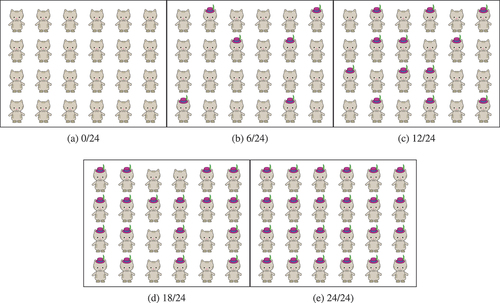
displays the number of items that included each of these types of picture.
Table 1. The number of items per condition.
2.2. Results
Utterances produced by participants were recorded during the session. Afterward, they were transcribed by a native speaker and were verified by another native speaker. Finally, the features of each utterance, such as the position of the expression and whether the produced form contained sentential negation, were coded by a native German-speaking author.
Excluding the training items, there were 228 items produced by child participants and 180 items produced by adult participants (12 items per participant). Among these items, child participants produced kein 58 times and adult participants 35 times. We then excluded the items whose interpretation did not match the context or where the meaning was not clear. A summary of the presence of kein in the utterances of both adults and children for each experimental condition is shown in . As can be seen, both child and adult participants produced kein in (almost) all conditions, although the majority of the time it was produced with the target type of picture, where none of the cats were wearing a hat (0/24 picture).Footnote5 We did not observe the negative indefinite, co-occurring with a sentential negation, however.
Table 2. The number and frequencies of the use of kein in each experimental context.
As for the universal quantifier, child participants produced them 39 times and adult participants produced them 44 times. The summary of the use of alle is shown in .
Table 3. The number and frequencies of the use of alle in each experimental context.
Next, we had a look at the grammatical function of negative determiners by focusing on the data associated with the 0/24 picture, because it was the only context where a sentence could contain kein in either the subject or the object role and still convey the target meaning. The data from the 24/24 picture was also included to serve as a control context, where we can check whether the design elicits the type of structure that we expect them to. With the 24/24 picture, the only way to describe the picture with a universal quantifier is by placing it in the subject position. This left us with the number of utterances outlined in .
Table 4. Number of utterances in final dataset.
The novel observation that we made from this set of data was that children produced kein in the object position, although the experiment was designed to elicit the production of kein in the subject position. An example is shown in (9).
In , we show the number of times kein and alle are used in subject and object positions, separated by the age group, and the data are visualized in .
Figure 3. Rate of target determiner in subject role for both groups, when describing 24/24 or 0/24 pictures. The vertical bars reflect the standard error. Dots correspond to individual participants’ means. A horizontal jitter of 0.1 and vertical jitter of 0.025 were applied for better visualization.
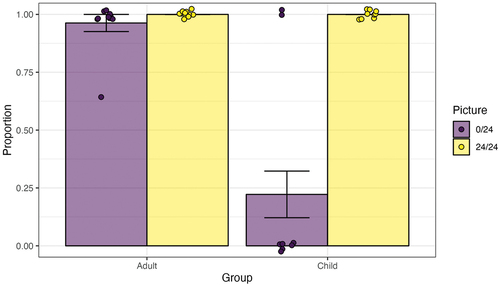
Table 5. Utterances that conveyed target meaning, contained target determiner, and where the grammatical role of this determiner was clear.
As can be seen, adult utterances describing both types of pictures unanimously employed the relevant determiner as the subject of the sentence, which is expected given the design. In contrast, though children followed adults in describing 24/24 pictures with universal quantifier subjects, they produced negative indefinite subjects less frequently. We generated a mixed effects logistic regression model of the utterances describing 0/24 pictures, with group as a fixed effect and a random intercept for participant. Utterances describing 24/24 pictures were not included because of their lack of variation. Footnote6 Comparison of this model with a model that was equivalent, except that it lacked the group fixed effect, using a likelihood ratio test indicated a significant effect of group ((1) = 15.89, p
.001) between the models. It is clear from that this is caused by children producing fewer utterances with negative indefinite subjects than adults.
shows examples of the utterances that children produced when describing the 0/24 pictures and the number of times each type of structure was produced. Utterances were coded based on whether they contained the relevant determiner/s and/or focus operators, as well as their grammatical role. That is, ‘all(cat).no(hat)’ sentences were required to contain a universal quantifier subject and a negative indefinite object, ‘only(cat).no(hat)’ contained a focus operator subject and a negative indefinite object, and ‘no(cat).hat’ contained a negative indefinite subject and neither of our targeted determiners in the object role.
Table 6. Utterances produced by children to describe 0/24 pictures.
2.3. Discussion
The goals of Study 1 were to elicit sentences with quantification and to observe the linguistic environments where negative indefinites are produced. Given that previous studies showed that German-speaking preschool children frequently interpret two negative elements as one (negative concord) and produce negative indefinites in an environment akin to the negative concord, we tested whether 3- to 6-year-old children would produce negative concord. The result of this test shows that the tested children behaved like adults in that they did not produce negative concord. Secondly, we observed in an exploratory analysis that 3- to 6-year-old children’s use of negative indefinites differs from that of adults in a previously unobserved way: despite the study being designed to elicit subject negative indefinites, children largely produced negative indefinites in object position. In contrast, adults’ productions were in line with our design, producing negative indefinites almost exclusively in subject position. Furthermore, we only find this pattern with negative indefinites: both children and adults produced universal quantifier alle ‘all’ in subject position. The first result is possibly a function of the children’s age: As we mentioned above, corpus studies found that such sentences are mainly produced by German children less than 3 years of age (Nicolae & Yatsushiro Citation2022; Driemel et al. Citation2023; Hein et al. Citation2023).Footnote7 Moreover, as noted above, the Meaning First approach does not expect children who are still acquiring a construction to always produce the underlying content. It is possible, therefore, that the relevant children do sometimes produce negative concord utterances but that we simply did not capture any such examples during our experimental session. It is nonetheless interesting to note that this result, combined with the previous results from (Nicolae & Yatsushiro Citation2022), indicates that German-speaking children achieve adult-like performance in the production of such sentences before they do so with regard to comprehension. We leave this issue for future studies.
As for the environments where the universal quantifier and the negative indefinites are produced, the divergence in the frequencies in the use of these expressions in the subject position among child participants is puzzling, given that adults produced them all in the subject position. To see whether this asymmetry is an experimental artifact, we conducted Study 2, where we explored whether the asymmetry appears in the naturalistic speech of German-speaking children’s corpus transcripts.
3. Study 2: corpus search
The aim of Study 2 was to explore whether the asymmetry we found regarding the position where negative indefinites are produced would also appear in child language corpora. If they do, then this would indicate that this pattern is not merely an artifact of our experiment and so is worthy of further exploration and serious consideration of its implications for relevant theories.
Note that this corpus search differs from those conducted by Nicolae & Yatsushiro (Citation2022) and Hein et al. (Citation2023) in the following respects. Nicolae & Yatsushiro (Citation2022) searched for any instances of German-speaking children producing negative concord utterances with the negative indefinite, independent of the position the negative indefinite may occupy. As for Hein et al. (Citation2023), they were also primarily interested in finding negative concord utterances. However, to check whether the occurrences of negative concord indicated a strict or non-strict negative concord grammar, Hein et al. (Citation2023) also presented a breakdown of the position of the negative indefinites. They found that German-speaking children produced many more negative indefinites following the finite verb (postverbal) than preceding it (preverbal). This contrasted with their search of negative indefinites in English, where this asymmetry was not present. In the current study, we coded the negative indefinites not only for their position relative to the finite verb (i.e., pre- vs. postverbal) but also for their grammatical role (i.e., subject vs. object). Moreover, in a follow-up search focusing on Leo (Behrens Citation2006), who contributed most of the data of the initial corpus search, we investigated his utterances with universal quantifiers, as well as the utterances of his mother, which provides an important comparison.
3.1. Initial corpus search
3.1.1. Method
We collected data from all available German corpora (as of December 2021) in the CHILDES database (MacWhinney Citation1991). The data set included 43 German-speaking (typically developing) children aged 0;06–14;10, including utterances from the following eight corpora: the Caroline corpus (MacWhinney Citation1991), the Grimm corpus (Grimm Citation2007), the Leo corpus (Behrens Citation2006), the Manuela corpus (Wagner Citation2006), the Miller corpus (Miller Citation1979), the Rigol corpus (Lieven & Stoll Citation2013), the Stuttgart corpus (Lintfert Citation2009), and the Wagner corpus (Wagner Citation1985). The total number of child utterances amounted to 363,028.
We extracted all child utterances that contained at least one negative indefinite (kein, niemand, nichts, niemals and relevant inflected forms). We further excluded utterances by children who were older than the oldest child who participated in Study 1, namely, 6;2 years. This resulted in 3,061 relevant utterances.Footnote8
Each utterance was coded for the type of negative indefinite, grammatical function (subject vs. object) and position (preverbal or postverbal). Fragment utterances that did not contain a verb, participle, or predicational element were annotated and excluded from further analysis, leaving us with 2,412 utterances. All annotations were done by two native speakers of German.
3.1.2. Results
In and , we show the positional distribution of negative indefinites with respect to the inflected verb in the sentence. Excluded from the count are utterances in which the position of the verb was fixed in verb-final (embedded clauses) or verb-initial position (polar questions) for independent reasons. This left us with 2,111 utterances, of which 88 showed a negative indefinite in preverbal position and 2,023 in postverbal position. As can be seen in , most of the negative indefinites produced by the children include kein, as in, for example, keine Katze ‘no cat’, and niemand was the least produced negative indefinite.
Table 7. Number and frequencies of negative indefinite types by position and results of the one-sample proportion z tests.
For each negative indefinite, we conducted a one-sample proportion z test with a continuity correction to determine whether the rate at which it appeared in the preverbal position in utterances was significantly less than 50%. The results of these tests are presented in and indicate that, for all of the different types of negative indefinite, including kein, which was tested in Study 1, they show up significantly less often in the preverbal position compared to the postverbal position.
Crucially, an asymmetry can also be found in the grammatical function of the negative indefinite kein produced by the German-speaking children. In and , we see the distribution of negative indefinites according to whether they were used as subjects or objects in the sentences. Excluded from the count are utterances containing niemals and all copula clauses. This results in 1,750 utterances containing negative indefinites, with 169 produced as a subject and 1,581 produced as an object. Again, for each negative indefinite, we conducted a series of one-sample proportion z tests with a continuity correction to determine whether the rate at which it appeared as the subject of the sentence was significantly less than 50%. The results of these tests are presented in and indicate that, though kein and nichts show up significantly less often as the subject of the sentence, this is not the case for niemand. We attribute the high percentage of niemand subjects to the well-known animacy bias agents/subjects display across languages: animates constitute prototypical subjects, whereas inanimates are prototypical objects (Silverstein Citation1976; Comrie Citation1989). Informative for our research question, therefore, is only the distribution of kein which is neutral toward animacy.
Table 8. Number and frequencies of negative indefinite types by grammatical function and results of the one sample proportion z tests.
Overall, the results from Study 2 corroborate the results we obtained in Study 1, where we observed children producing the negative indefinite kein significantly more frequently in the object position than in the subject position. This hence gives evidence that the finding in Study 1 was not an experimental artifact.
3.2. Follow-up corpus search
As a reviewer pointed out, our initial corpus study was not designed to fully mirror the results of Study 1, where, on the one hand, children were producing negative indefinites more often in object than in subject position compared to adults and, on the other hand, did not display such an asymmetry for the universal quantifier alle. To investigate this, we conducted a further corpus search, focusing on the distribution of the universal quantifier alle in child and adult speech as well as the use of kein by adults. For practical reasons, we restricted our search to the child whose contribution to the initial search was largest at 36% of all utterances—Leo from the Leo corpus (Behrens Citation2006). Leo was recorded regularly over the span of 3 years from age 1;11 to 4;11, creating a corpus of 151,356 utterances. In addition, we investigated the distributions of negative indefinites and universal quantifiers in the transcribed speech of Leo’s mother. This was done to see whether the difference between children and adults observed in Study 1 could also be found in the corpus data.
3.2.1. Method
We began by identifying all of Leo’s utterances containing the negative indefinite kein, which resulted in 838 utterances (excluding fragments). We then excluded utterances with a participle or predicational element, as well as utterances with a fixed position of the verb, leaving us with 539 utterances. We went on to extract all child utterances containing a universal quantifier (alle and relevant inflected forms) from the Leo corpus. This resulted in 729 utterances (excluding fragments). We then excluded utterances with a participle or predicational element, as well as utterances with a fixed position of the verb, leaving us with 499 utterances. In the same manner, we collected all utterances of Leo’s mother that contained a negative indefinite, amounting to 902 utterances (excluding fragments), and all utterances that contained a universal quantifier, resulting in 1,844 utterances (excluding fragments). Again, we further excluded utterances with a participle or predicational element, as well as utterances with a fixed position of the verb, leaving us with 628 negative indefinite utterances and 800 universal quantifier utterances. Each of these utterances was coded for the position and grammatical function of the relevant determiner. All annotations were done by two native speakers of German.
3.2.2. Results
shows the positional distribution of kein and alle in Leo’s utterances with respect to the inflected verb. Of the 539 utterances containing kein, in 41 cases of kein appear in a preverbal position and in 498 it appears postverbally. As for the 499 utterances with a universal quantifier, in 215 utterances alle occupies a preverbal position, whereas it appears in a postverbal position 284 times. We conducted a generalized logistic regression analysis with position of the determiner (preverbal vs. postverbal) as the response measure and type of determiner (alle vs. kein) as the predictor. We found that there was a significant effect (logit coefficient: -2.22, SE = 0.19, z = -11.93, p .001), with negative indefinites being less likely to appear preverbally than universal quantifiers.
In we present the distribution of kein and alle in Leo’s utterances depending on whether they were used as a subject or an object.Footnote9 This resulted in 68 utterances with kein as a subject and 471 as an object. The universal quantifier alle appeared as a subject in 245 utterances and as an object in 254 of them. We conducted a generalized logistic regression analysis with role of the determiner (subject vs. object) as the response measure and type of determiner (all vs. kein) as the predictor. We found that there was a significant effect (logit coefficient: -1.9, SE = 0.16, z = -12.05, p .001), with negative indefinites being less likely to appear in subject role than universal quantifiers.
Note that, though there is an asymmetry between subject and object positions in the distribution of the negative indefinite kein, no such asymmetry is observed for the universal quantifier alle.
Turning to the utterances of Leo’s mother, shows the positional distribution of kein and alle in direct comparison to Leo’s, excluding copular clauses and utterances where the inflected verb is independently fixed at the left or right clause-periphery. Of the resulting 628 utterances containing a form of kein, 10 showed it in preverbal position and 618 in postverbal position. For the universal quantifier, we were left with 800 utterances. Of these, 163 contained alle in preverbal position and 637 in postverbal position. We conducted a generalized logistic regression analysis with position of the determiner (preverbal vs. postverbal) as the response measure and type of determiner (alle vs. kein), speaker (Leo vs. Leo_MOT), and their interaction as the predictors. We found that there was a significant main effect of determiner (logit coefficient: -2.22, SE = 0.19, z = -11.93, p .001), with negative indefinites being less likely to appear in preverbal position than universal quantifiers. We also found a significant main effect of speaker (logit coefficient: -1.08, SE = 0.13, z = -8.61, p
.001), with Leo producing more determiners in preverbal position than his mother. Finally, we did not find a significant interaction effect between determiner and speaker (logit coefficient: -0.54, SE = 0.38, z = -1.43, p = .15)
shows the distribution of kein and alle in the utterances by Leo’s mother, sorted by the grammatical function of these expressions in direct comparison to Leo’s distribution. As before, the plot excludes copular clauses and clauses with a fixed peripheral position of the verb. It also excludes cases where alle appears in an adjunct. In the 628 utterances with kein it was used as a subject in 62 utterances and as an object in 566 utterances. As for the universal quantifier alle in argument position, it appears as the subject in 348 utterances and as an object in 449 utterances, out of the total 797 utterances. We conducted a generalized logistic regression analysis with grammatical role of the determiner (subject vs. object) as the response measure and type of determiner (alle vs. kein), speaker (Leo vs. Leo_MOT), and their interaction as the predictors. We found a significant main effect of determiner (logit coefficient: -1.9, SE = 0.16, z = -12.05, p .001), with negative indefinites being less likely to appear in subject role than universal quantifiers. We did not find a significant main effect of speaker (logit coefficient: -0.22, SE = 0.11, z = -1.9, p = .06). Finally, we did not find a significant interaction effect between determiner and speaker (logit coefficient: -0.06, SE = 0.22, z = -0.26, p = .79).
Figure 9. Proportion of different determiners by argument type in Leo’s and Leo’s mother’s utterances.
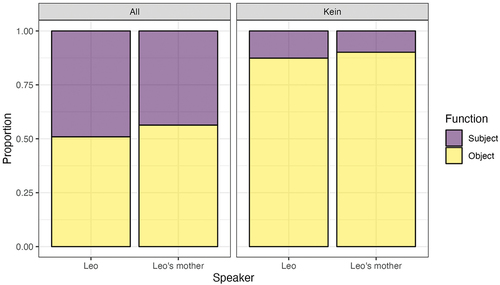
We observe that the distributions of quantifiers in Leo’s and his mother’s utterances are very similar, in particular the one by argument type.Footnote10
3.3. Discussion
The elicitation experiment conducted in Study 1 revealed an apparent asymmetry between subject and object positions in German-speaking children’s production of negative indefinites. To exclude the possibility that this asymmetry was an experimental artifact, we conducted a corpus search of German CHILDES corpora to see whether the same asymmetry would appear in more naturalistic corpus data. As we have seen above, the asymmetry between subject and object positions that we found in Study 1 was replicated in this search, indicating that this is a robust pattern, deserving of an explanation.
The Leo corpus data furthermore revealed that no comparable asymmetry holds for the universal quantifier in subject vs. object position. Interestingly, Leo’s mother produced negative indefinite subjects as infrequently as Leo did, although in Study 1, adult speakers produced negative indefinites in subject position in almost all of the trials where they were predicted to do so. At first glance, this pattern of results appears somewhat puzzling.
Recall, however, that the design of the experiment in Study 1 encouraged the use of quantificational expressions in the subject position. We thus assume that the results of Study 1 and 2 combined further indicate that adult speakers can produce negative indefinites in the subject position when necessary but that when there is no such pressure, as is the case in naturalistic corpus data, the position effect holds even for adults. An anonymous reviewer pointed out that, rather than being a function of the noted variation in experimental vs. naturalistic contexts, the noted asymmetry could be a function of whether an adult is speaking to a child or not. We cannot rule out this possibility; however, we would note that, even in that case, there would be the question of why adults would adjust their speech in this manner. That is, what is it about sentences with subject negative indefinites that is intuited by adults as not being “child-friendly”?Footnote11
In other words, the results from Study 1 and Study 2 seem to converge: both German-speaking adults and (especially) children produce negative indefinites in the object position more frequently than in the subject position. Now, the question is why there should be such an asymmetry. According to the quantifier approach, negative indefinites are composed of a single semantic unit—a negative existential generalized quantifier–and sit alongside existential and universal quantifiers. It is unclear, then, from the perspective of this approach, how one might go about accounting for the noted asymmetry in sentences containing negative indefinites. In contrast, by treating negative indefinites as being composed of multiple semantic units with a certain scopal relationship, the decomposition approach has a more direct path to capturing these results. That is, if one adopts a few additional and independently motivatable assumptions, the asymmetry can be explained, within the decomposition approach, as a function of the processing cost of reconstruction. Specifically, one would have to adopt the assumptions in (10).
Once these assumptions are in place, the negative indefinite subject-object asymmetry could be seen as being motivated by speakers avoiding utterances with higher processing costs. That is, the assumptions in (10a) and (10b) require that sentences with a negative indefinite subject involve the negative indefinite being moved to a position that is outside the scope of negation, meaning it must be reconstructed for correct interpretation, where it is in the scope of negation, to be achieved. The assumption in (10c) would then dictate that this sentence is associated with a higher processing cost than a similar sentence that does not require reconstruction. Many other sentences express equivalent meanings but do not require reconstruction. As a result, German speakers (both adults and children) tend to produce these utterances instead. Study 1 presented a context in which the context made it clear that a sentence with a negative indefinite subject was the most appropriate. German-speaking adults were sensitive to this manipulation and, as a result, produced sentences with negative indefinite subjects, despite their higher cost. In contrast, either German-speaking children were not sensitive to these aspects of the context or the processing cost of such sentences was too high for them (or both), and so they instead produced sentences that had an equivalent meaning but did not involve reconstruction.Footnote12
We will leave a discussion of motivating these assumptions and a more in-depth presentation of the analysis for the General Discussion. However, one thing that is not yet clear from the production data revealed so far is the extent of the difficulty of sentences with negative indefinite subjects: Would the subject-object asymmetry that was found in Study 1 and Study 2 extend to comprehension, especially for children, for whom this asymmetry seems to be especially strong? It is possible, for example, that they are able to comprehend sentences containing the negative indefinite in the subject position perfectly fine, even though children tend not to produce these sentences. Alternatively, children’s comprehension might also be affected, either in the sense that they are unable to access any interpretation of these sentences or in the sense that they access a non-adult interpretation. For example, it is possible that children might access an interpretation of a subject negative indefinite sentence like (11a) that corresponds to (11b). Such an interpretation would amount to the negative indefinite being interpreted as though it were associated with the object of the sentence.
One might wonder about the plausibility of children accessing such an unusual interpretation. However, there is previous work on children’s comprehension of sentences with focus particles in which children access a similar interpretation. That is, it has been found that children often interpret sentences with the focus particle ‘only’ in subject role as though it were lower in the sentence. Specifically, a series of studies have found that when interpreting sentences like (12a), where the focus particle should be associating with the subject, children will often interpret the sentences as though the focus particle is rather attached to the verb phrase, as in (12b) (Crain, Ni, & Conway Citation1994; Notley et al. Citation2009; Zhou & Crain Citation2010; Müller, Schulz, & Höhle Citation2010; Sugawara Citation2016; Crain Citation2017).
Of course, without some further link between sentences with focus particle subjects and those with negative indefinite subjects, it is not clear why we should expect such a result to generalize. Fortunately, such a link is provided by a recent analysis of focus particles by Hirsch (Citation2017), in which focus particles are analyzed in a manner that mirrors in many ways the decomposition approach to negative indefinites. According to Hirsch (Citation2017), sentences with focus particles attaching to the DP, like (13a), should be decomposed such that they are made up of a silent ‘ONLY’ at the vP, as in (13b), with the ‘only’ in (13a) spelling out a syntactic head at the DP level, which is semantically inert but marked for agreement with the covert ONLY. As illustrated in the parallels between (13) and (14), this analysis ends up generating a very similar picture of focus particles as that generated by the decomposition approach to negative indefinites. In fact, Hirsch (Citation2017) stated that, according to his proposed decompositional approach to focus particles, these two phenomena should be considered as belonging to the same class.
Given this proposed similarity between focus particles and negative indefinites, it is possible that children’s subject-object asymmetries in Studies 1 and 2, and children’s non-adult interpretations of sentences like (12a) are in some sense related. If this is on the right track, it raises the possibility that children might also access non-adult interpretations of sentences with negative indefinite subjects that are parallel to the interpretations accessed for sentences with focus particle subjects, specifically, that children will interpret sentences with negative indefinite subjects as though the subject was not in the scope of negation. This would mean that they interpret a sentence like (11a) as (11b). If this was the case, then children’s avoidance of sentences with negative indefinite subjects in Study 1 might actually be a function of the interpretation in (11b) being an inappropriate description of the relevant picture (i.e., where no cats are wearing hats). Moreover, it would encourage the development of a common explanation for children’s difficulties with these different sentences, whether it be processing costs associated with reconstruction or something else.
In Study 3, we present a comprehension experiment designed to explore and test this possibility further .
4. Study 3: comprehension experiment
The results from Study 1 found a subject-object asymmetry in German-speaking children’s production of negative indefinites. Study 2 replicated this result in corpus data, and also found this asymmetry in the child-directed speech of a German-speaking adult. One thing that is not yet clear is whether this asymmetry might also show up in some form in German-speaking children’s sentence comprehension. For example, if the processing cost for comprehending sentences with negative indefinite subjects is very high due to reconstruction, then children may access a non-adult interpretation of them or fail to access an interpretation altogether. In either case, we would expect this to be revealed through lower accuracy in interpreting sentences with negative indefinite subjects, compared to those with negative indefinite objects.
Note that before the collection of any data we published a preregistration of the hypothesis, method, and planned statistical analysis of this experiment on the Open Science Foundation website. The preregistration can be accessed here: https://osf.io/6n92p
4.1. Method
4.1.1. Participants
Thirty-six children (3;10–5;11, M = 4;9)Footnote13 and 37 adults participated in the experiment. Children were recruited from online child participant recruitment platforms, as well as from daycare centers in the Berlin area. Adults were recruited from the online participant recruitment platform Prolific. The experiment took approximately 10 minutes to complete and adults were paid 2.00 GBP. Children were given a sticker for participation. We only included participants who (i) had acquired German as a native language, (ii) did not have any language or hearing impairments, and (iii) were not exposed regularly to any other language before the age of 5.
4.1.2. Procedure
We employed a Truth Value Judgment Task (Crain & Thornton Citation1998), implemented on the experiment creation software PCIbex (Zehr & Schwarz Citation2018). As shown in , participants were presented with a series of pictures and were required to press on the ‘dog face’ to hear a sentence description of the picture. Participants then had to judge whether the sentences were accurate descriptions of the pictures by pressing a ‘green smiley face’ if it was true and a ‘red sad face’ if it was false.
4.1.3. Materials
Each of the pictures that the cartoon dog attempted to describe was composed of a grid of 24 cats (6 x 4). These pictures varied with regard to the number of cats that were wearing a hat, as shown in . The sentences produced by the cartoon dog are shown in (15)–(18).
4.1.4. Design
Our experimental design included three types of items: critical, control, and filler. presents the properties of the different items, including the correct response and the number of items that were presented during the session. The order in which these items were presented was randomized for each participant.
Table 9. Properties of the different items.
As shown in , the two critical conditions displayed the same picture (i.e., 23/24 ()) but varied with regard to the sentence that was presented. Specifically, whereas KeinEin-23 presented the KeinEin sentence in (15), AlleKein-23 presented the AlleKein sentences in (16).
If children accessed an adult-like interpretation of either the KeinEin or AlleKein sentences, they were expected to reject the sentences (i.e., select the sad face). However, if children accessed the noted non-adult interpretation of these sentences (i.e., (11b)) or were simply confused, they were expected to accept the sentence (i.e., select the happy face).
In the control items, participants were presented with the target sentences (i.e., either (15) or (16)) describing a context that was expected to be true/false according to all possible interpretations of the relevant sentence.
4.2. Results
Our analysis of the data from this study proceeded in two steps: first, we conducted the analysis outlined in our preregistration (https://osf.io/6n92p) looking at participants’ response accuracy; next, we conducted an exploratory analysis, focusing on participants’ response times. Before outlining these analyses, however, we will consider participants’ performance in the control conditions.
4.3. Control conditions
In addition to the two critical and four filler conditions, participants were presented with four different control conditions. As mentioned above, these conditions presented the target sentences as either clearly true/false descriptions of the relevant pictures. As shown in , the adult group’s performance in these conditions was over 90%.
Figure 12. Response accuracy across control conditions. The vertical bars reflect the standard error. Dots correspond to individual participants’ means. A horizontal jitter of 0.1 and vertical jitter of 0.025 were applied for better visualization.
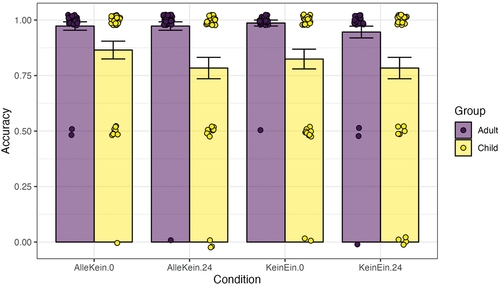
We generated a mixed effects logistic regression model of response accuracy, with group, condition, and their interaction as fixed effects. Following Barr et al. (Citation2013), we started with a “maximal” random effect structure including intercepts for participant and item, as well as by-item slopes for group and by-subject slopes for condition. To achieve model convergence, we removed, in a step-wise manner, the pieces of the random effect structure with the least variance, resulting in a structure containing only an intercept for participant. This model was then compared to models that were equivalent, except that they lacked one of the fixed effects, using a likelihood ratio test. These comparisons revealed a significant effect of group ((1) = 19.68, p
.001) but no significant effect of condition (
(3) = 2.62, p
.45) nor any significant interaction between group and condition (
(3) = 1.84, p
.61). It is clear from that the group effect is caused by children producing fewer accurate responses than adults. We also conducted a series of one-sample proportion z tests with a continuity correction to determine whether the rate at which it appeared in the preverbal position in utterances was significantly more than 50%. The results of these tests, presented in , indicate that children’s accuracy across all conditions was significantly higher than chance. We take these results as indicating that the participants in both groups understood the task to a sufficient degree and proceed now to the planned analysis.
Table 10. Results of one-sample proportion z test.
4.3.1. Planned analysis
We generated a mixed effects logistic regression model of response accuracy, with group, condition, and their interaction as fixed effects.Footnote14 Following Barr et al. (Citation2013), we started with a “maximal” random effect structure including intercepts for participant and item, as well as by-item slopes for group and by-subject slopes for condition. To achieve model convergence, we removed, in a step-wise manner, the pieces of the random effect structure with the least variance, resulting in a structure containing only an intercept for participant. This model was then compared to models that were equivalent, except that they lacked one of the fixed effects, using a likelihood ratio test. These comparisons revealed a significant effect of group ((1) = 23.51, p
.001) but no significant effect of condition (
(1) = 0.42, p
.52) nor any significant interaction between group and condition (
(1) = 0.08, p
.78). It is clear from that the group effect is caused by children producing fewer accurate responses than adults.
4.3.2. Exploratory analysis
The lack of any difference between conditions in the response accuracy of participants could be indicative of there being no difference in the difficulty of comprehending these different sentences. Alternatively, it could be that KeinEin sentences are more difficult to process than AlleKein sentences but that this difficulty is not sufficient to result in any differences in non-target interpretations/responses. If this explanation is on the right track, we might expect the predicted difference to be visible in the more processing focused measure of “response time.”
To explore this possibility, we looked at the response times associated with responses in our two critical conditions. We started out with 148 data points in each condition for adults and 144 in each condition for children. We then excluded any response times that were associated with incorrect responses. For the child group, this resulted in removing 27 (19%) of the data points from the AlleKein.23 condition and 30 (21%) of the data points from the KeinEin.23 condition. For adults, it resulted in the removal of 2 (1%) of the data points from the AlleKein.23 condition and 3 (2%) of the data points from the KeinEin.23 condition. The response times were calculated from the sentence offset. The raw data are presented in . Following Whelan (Citation2008), to reduce the influence of outliers and to satisfy the assumption of a normal distribution, we conducted a logarithmic transformation of the data. The transformed data are presented in .
Figure 14. Raw response times across groups and critical conditions. The vertical bars reflect the standard error. Dots correspond to individual participants’ means. A horizontal jitter of 0.1 and vertical jitter of 0.025 were applied for better visualization.
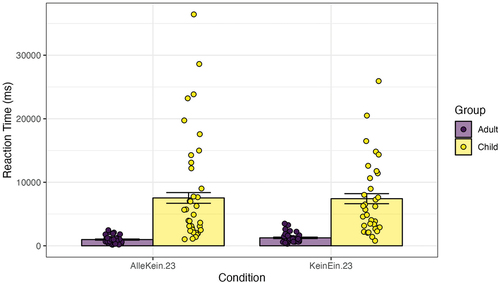
Figure 15. Logarithmically transformed response times across groups and critical conditions. The vertical bars reflect the standard error. Dots correspond to individual participants’ means. A horizontal jitter of 0.1 and vertical jitter of 0.025 were applied for better visualization.
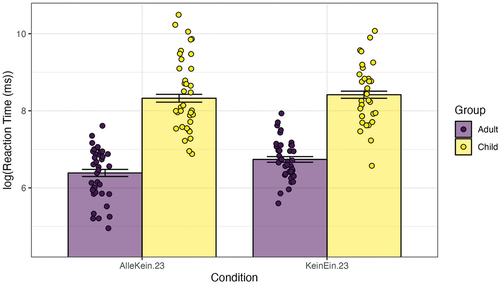
With this final data set, we generated a mixed effects linear regression model of response time, with condition, group, and their interaction as fixed effects. Group and condition were sum-coded. The maximal random effect structure which achieved convergence included an intercept for participant and by-condition slopes for participant. We compared this model to a series of models that were equivalent, except that they lacked one of the fixed effects using a likelihood ratio test. These comparisons revealed a significant effect of group ((1) = 80.42, p
.001) and condition (
(1) = 6.50, p
.05), and a significant interaction between group and condition (
(1) = 4.13, p
.05). As shown in , the group effect is a result of children’s response times being higher than those of adults. Moreover, the condition effect is generated through the response times in the KeinEin.23 condition being higher than those in the AlleKein.23 condition. The interaction effect is a function of the difference in response times between conditions being greater for adults than for children.
4.4. Discussion
The aim of this study was to explore whether the subject-object asymmetry with negative indefinites, revealed in Study 1 and Study 2, might also be revealed in comprehension. Specifically, we were interested in the possibility that children would access some non-adult interpretation of these sentences, like (19).
In this case, the expectation was that children would accept sentences with negative indefinite subjects (i.e., (20)) to a greater degree than sentences with negative indefinite objects (i.e., (21)) when used to describe a 23/24 picture (i.e., )
We found no difference in either group when it came to response accuracy between the two sentence types. Therefore, we have no evidence that the asymmetry found in production extends to children’s comprehension. Moreover, we did not find any evidence of children accessing an interpretation of our target sentences akin to what has been found with focus particles (e.g., Crain, Ni, & Conway Citation1994), wherein the negative indefinite is interpreted as though it was associated with a phrase lower down in the sentence (e.g., vP). A possibility raised by the decompositional account of focus particles proposed in (Hirsch Citation2017). We conducted a further exploratory analysis to determine whether we nonetheless can detect the asymmetry reflected in response times. This analysis found that, indeed, the response times associated with KeinEin sentences were higher than those associated with AlleKein sentences for both adults and children.Footnote15
Together, these results seem to indicate that, though the difficulty with negative indefinites in subject position does not affect comprehension accuracy, it is reflected in the processing of these utterances, giving further support for the hypothesis that KeinEin sentences are in some way more difficult than AlleKein sentences.
5. General discussion
In the current article, we present a series of studies exploring German-speaking children’s behavior with negative indefinites. Testing the production of universal quantifier alle and negative indefinites in German, we found an interesting asymmetry where children seem to avoid producing the negative indefinite in subject position, whereas adults do not (Study 1). This asymmetry was corroborated by the corpus data and was found to be present also for adult speakers (Study 2). We explored whether the asymmetry is observable also in a comprehension experiment (Study 3) and though we did not find any evidence of children accessing an interpretation whereby the negative indefinite was associating with a lower phrase, we did find that sentences with subject negative indefinites were associated with increased response times for both adults and children. We will now consider each of these results and their theoretical implications in more detail.
5.1. Asymmetry with subject or first position?
Up to this point, we have been interpreting children’s behavior as indicating a negative indefinite subject-object asymmetry. However, one might wonder whether this asymmetry was, rather, related to the placement of negative indefinites in the “first position” or “prefield” of the sentence. German is V2, and in principle the first position can be occupied by any phrase, not necessarily the subject. So it is possible for the subject of the sentence to come before or after the finite verb. However, when describing all of the pictures (also when the 0/24 pictures are excluded), participants (both adults and children) tended to do so by producing sentences with the subject determiner phrase in the first position. Assuming that whatever factors led to this preference for the other picture descriptions were also present for the 0/24 pictures, children’s utterances may have been an attempt to avoid placement of the negative indefinite in the first position, rather than an avoidance of negative indefinite subjects.
We explored this possibility further by conducting an additional production experiment. Specifically, we created an experiment that was identical to Study 1, except that it was designed to encourage participants to fill the first position with another element (i.e., jetzt ‘now’), to investigate whether they might then produce a negative indefinite subject in the postverbal position, as in (22). This was achieved by altering the training phase, such that participants learned that they needed to begin each utterance with jetzt ‘now.’
The results of this experiment, contrasted with the results of Study 1, are shown in . We found that there was no significant difference in the rate of negative indefinite subjects produced between the two studies.Footnote16
Figure 16. Comparison of the rates at which children produced utterances with the target determiner in subject role between Study 1 and the follow-up Study 1b. The vertical bars reflect the standard error. Dots correspond to individual participants’ means. A horizontal jitter of 0.1 and vertical jitter of 0.025 were applied for better visualization.

We take these results as indicating that the asymmetry is with subject-object and not related to the first position. A more comprehensive investigation of this question would be justified, however, and we leave this for future research.
5.2. Explaining the negative indefinite subject-object asymmetry
The negative indefinite subject-object asymmetry present in our data is (to our knowledge) not a clear prediction of any existing analysis of negative indefinites. This was one of the reasons why, after finding this pattern in Study 1, we decided to test its robustness by (i) searching for its replication in child language transcripts and (ii) investigating whether it might also affect children’s comprehension. The corpus search in Study 2 replicated the pattern, with a clear difference in frequencies between two positions. Moreover, this study found that this asymmetry extends to adults. As for the comprehension experiment conducted in Study 3, it revealed that though this pattern did not impact comprehension, it could be detected in the response times of both adult and child participants, indicating that it exhibited a correlation with language processing.
The correlation between frequency of occurrence and processing difficulty we identified raises the question of whether there is a causal relation and, if so, in which direction. Recall that a similar correlation is found at the lexical level: frequent words are easier to process (Oldfield & Wingfield Citation1964 and others). Although it is plausible in the lexical case that a word’s frequency is the cause of processing ease via faster lexical retrieval, the issue is less clear-cut in the case at hand, and that processing ease is the cause of frequency is at least as plausible as the reverse direction of causation. Consider first the commitments that would be needed on the assumption that frequency was the cause of processing ease. Recall that we observe a correlation between the frequencies at which adults and children use negative and universal quantifiers in Study 2. But, if the correlation was caused solely by frequency, such a mechanism would presuppose that German 3-year-olds had already attended to and generalized the differential frequencies of universal and negative expressions in both subject and object position in adult speech to match them. Furthermore, a frequency-based proposal would require additional assumptions to explain the child-adult difference in Study 1 and the response time effect in Study 3. In sum, though it is possible that the relative frequency of these expressions is somewhat responsible for the effects we found across our studies, we take it that, on its own, it is an insufficent explanation. We therefore proceed with a detailed discussion of how German negative indefinites in subject position may cause cognitive difficulty.
As for explaining specifically where this difficulty might come from, it seems to us that a decomposition approach to negative indefinites has an advantage, due to its analysis of negative indefinites as an indefinite sitting in the scope of negation. As outlined below, the fact that this analysis assumes two elements, with a certain scope arrangement, provides a natural avenue for explaining the noted positional asymmetries in negative indefinite utterances. In contrast, the quantifier approach’s treating of negative indefinites as a unary element—that is, as a negative quantifier, sitting alongside universal and existential quantifiers—makes it difficult for such analyses to explain this pattern, without introducing more fundamental (and otherwise unmotivated) stipulations.
In the remainder of this section, we will sketch an account that can explain why subject negative in German are cognitively difficult .
As mentioned above, one possible way to capture the asymmetry between the subject and object negative indefinites is via the adoption of the three assumptions in (23).
The assumption in (23a) can be motivated through the observation that in languages like Romanian, where the negation is always overt, it is fixed at a position immediately dominating the verb. We take this as being indicative of the position of negation in all languages (whether overt or covert). More concretely, we will assume, along with many others (Chomsky Citation1957; Pollock Citation1989; Penka Citation2011; Zeijlstra Citation2004; von Stechow Citation2012; Chung & Ladusaw Citation2004), that negation is fixed at the P edge taking scope above the proposition.
As for the assumption in (23b), we will have to take a brief detour into the literature on subject movement in German. Given the assumption that negation is fixed at the P edge and the commonly believed view that subjects are first merged in Spec,
P (Koopman & Sportiche Citation1991, and many others), (23b) implies that subjects raise to a position outside of
P, presumably Spec,TP. Although the EPP requirement is widely believed to exist for English, there is reason to doubt that this is also true for German (Grewendorf Citation1989; Diesing Citation1992; Wurmbrand Citation2001, Citation2006; Haider Citation2010, Citation2017). Arguments against obligatory subject raising come from a variety of observations, including the following: transitive subjects can be part of a topicalized
P, subjects can follow adverbials/modal particles that are assumed to mark the
P-boundary, and some clauses do not require a subject. We will spell out one argument against the EPP in German in more detail, which is related to scope freezing (Barss Citation1986; Sauerland & Elbourne Citation2002). This phenomenon is illustrated in (24), where the fronted XPs
is “frozen” for scope, in that movement out of
or reconstruction into
is prohibited. What is possible, however, is the reconstruction of
; that is, the interpretation of
in its base position (
). This leads the quantified element
contained in the moved XP
to take obligatory scope below
.
Table
Wurmbrand (Citation2001, Citation2006) observed scope freezing effects with unaccusative verbs and an additional dative argument. In (25a), the nominative argument can optionally take scope over the dative argument. In other words, the universal jede Übung ‘every exercise’ (=) can take scope over the existential mindestens einem Kind ‘at least one child’ (=
). This reading is blocked in (25b), where the VP is fronted. The blocking is identified as a scope freezing effect, because the VP (=
) seems to reconstruct into its base position, where the universal can only take narrow scope.
Table
Crucially, this explanation implies that the nominative argument must be licensed in situ. It does not move to Spec,TP overtly because it is fronted with the VP. Neither does it move covertly due to scope freezing. Given that nominative case is still assigned, Wurmbrand (Citation2001, Citation2006) concluded that this observation provides evidence for the lack of an EPP-feature on T in German. In other words, nominative case of the subject is licensed via Downward Agree, without movement to Spec,TP, shown in (26).
So far, then, we have not seen any support for the assumption in (23b). We will now turn to an observation that indicates that subject movement to Spec,TP must be an option for case/agreement licensing, in at least some environments in German. Bobaljik & Wurmbrand (Citation2005) identified such environments with restructuring configurations like (27). In its base position, the theme argument alle Fenster ‘all windows’ takes scope below the restructuring predicate vergessen ‘forget’; see (27a). Interestingly, in the long passive construction in (27b) this theme argument, now assigned nominative case, can only take scope over the restructuring predicate.Footnote17 In a sense, the scope property of the subject in long passive restructuring configurations (27b) can be seen as the mirror image of the subject’s scope behavior in simple predicate sentences (25b).
Table
The difference between simple predicates (25) and restructuring predicates (27) is that for the latter there is a greater distance between the T licenser and the nominative argument. Bobaljik & Wurmbrand (Citation2005) proposed that the complement to a lexical verb delineates an agreement domain, therefore making restructuring configurations like (27) involve two agreement domains. In contrast, simple predicates, as in (25), only involve one agreement domain. In (28), we sketch the long passive structure involving a restructuring predicate, given in (27b). Because the licenser and the licensee are not first merged in the same agreement domain, T cannot assign case to the DP in (28a). The licensee must establish an Agree relation in the outer agreement domain. In other words, the nominative argument has to undergo subject movement to matrix Spec,TP (28b). Bobaljik & Wurmbrand (Citation2005) proposed that this type of A-movement does not reconstruct; hence the obligatory wide scope of the universal in (27b). They assumed that licensing conditions must be met at LF and the subject would not be in the same domain as its licenser, if it were to reconstruct in its base position. So the only way to meet the licensing conditions at LF and in syntax is subject movement to Spec,TP, where the DP undergoes Spec-head Agree with T, as shown in (28b).Footnote18
The observations presented by Bobaljik & Wurmbrand (Citation2005) suggest that Downward Agree for agreement/case licensing can be blocked in certain syntactic configuration and that, in such cases, there seems to be a fallback option in German where subjects move to Spec,TP to undergo spec-head Agree. In light of this discussion, we would like to submit that children learning German struggle to license arguments via Downward Agree even with simple predicates, as in (25). If it is true that even in languages where the EPP arguably does not hold there must nevertheless be an option to license subjects via movement and spec-head Agree in certain domains, it follows that all languages allow for this option but that in some languages there is an additional more economical in situ option available. In other words, a language that displays subject licensing via Downward Agree also allows for a last resort option, which is subject movement and spec-head Agree. We hypothesize that children choose spec-head Agree as the default option and if the adult grammar provides a way for licensing via Downward Agree, it has to be acquired. In this way, we motivate the claim in (23b).
Finally, we have the claim in (23c) that reconstruction has a processing cost. We would like to motivate this claim by referencing results from the adult sentence processing literature. Specifically, Anderson (Citation2004) investigated adult processing of sentences like (29) and found evidence of a processing cost (in the form of slower reading times) associated with the inverse scope interpretation of this sentence (i.e., (29⇝)). This interpretation of sentences like (29) has been argued to be accessed via reconstruction (Hornstein Citation1995; Johnson & Tomioka Citation1997; Hackl, Koster-Hale, & Varvoutis Citation2012). Assuming such an analysis of these interpretations, we take Anderson (Citation2004)’s result as indicating that reconstruction has a processing cost, thus motivating the claim in (23c).
Pulling all of this together, our proposal is that German-speaking children’s difficulties with negative indefinite subjects are caused by such sentences having a higher processing cost. Specifically, for the negative indefinite subject to end up in its licensed position, such sentences require the reconstruction of the subject under negation, a feat that, we argue, is associated with some processing cost. As for German-speaking adults, they have the ability to license subjects via Downward Agree. Although this enables the production of negative indefinite subjects below C without engaging in reconstruction, it does not extend to matrix clauses where the subject is produced in Spec,CP, which explains the avoidance of subject/preverbal negative indefinites revealed by the adult corpus data in Study 2 and the delay in response times in Study 3. However, because German-speaking adults also have higher processing capacities, we expect adults to be less affected by such considerations when encouraged to produce subject negative indefinites, which is consistent with our results in Study 1.
As for how German-speaking children come to behave like adults, they need to acquire two things. First, they have to acquire the ability to license subjects via Downward Agree and, second, they need to develop higher processing capacities, such that they are able to deal with cases where the negative indefinite subject is part of a matrix clause (and so reconstruction is still required).
6. Conclusion
In the current article, we reported a series of studies exploring German-speaking children’s behavior with negative indefinites. We set out to explore whether these children might produce sentences with a redundant negative marker, a possibility predicted by a Meaning First–based decomposition analysis. The elicitation experiment in Study 1 revealed no evidence of such productions; however, this may have been a function of the participants’ “advanced” age. In any case, a different, and quite interesting, pattern did reveal itself— namely, a subject-object asymmetry in children’s production of negative indefinites. We explored this pattern further through a corpus search of child German and confirmed that this pattern was not limited to our experiment. Moreover, we found evidence of this asymmetry also in adult speakers. Finally, we explored whether the asymmetry extends to comprehension and discovered evidence of this difficulty also present in the response times of adult and child participants.
Having been convinced of the robustness of this observation, we explored a possible explanation from the perspective of the decomposition approach to negative indefinites, specifically that (i) negation is realized at fixed position above P, and (ii) (for children) the subject is always realized at a position above negation (i.e., Spec,TP) to be licensed for case/agreement. These assumptions mean that negative indefinite subjects are realized at a position outside the scope of negation and so need to be reconstructed back under negation to achieve an accurate interpretation. We propose that the processing difficulties associated with this feat result in (i) children (and adults) often not producing sentences with negative indefinite subjects, when possible, and (ii) delayed response times when interpreting sentences with negative indefinite subjects in comparison to sentences with negative indefinite objects.
Author contributions
Cory Bill, Uli Sauerland, and Kazuko Yatsushiro conceived the experimental question and conducted the experiment of Study 1, 1b, and 3. Imke Driemel and Johannes Hein conducted the corpus search in Study 2. Cory Bill conducted the statistical analysis of all studies. Imke Driemel annotated the production data of Study 1 and 1b. Cory Bill, Imke Driemel, and Kazuko Yatsushiro drafted the manuscript. Uli Sauerland furthermore acquired funding and ethical permissions and supervised the work. All authors revised and accepted the final version of the paper.
Acknowledgements
We thank all members of the LeibnizDream project for fruitful discussions of the ideas presented in this paper and the audiences at BUCLD 44, CGSW 36, CLS 58 and GALA 15 for their helpful comments on various parts of this work. We would also like to thank our student assistants Hannah Ida Hullmeine, Jesse Oskari Trumpfheller and Janel Zoske who helped us annotate the corpus data.
Disclosure statement
No potential conflicts of interest are reported by the author(s).
Data Availability
All data and statistical analysis scripts are available at: https://doi.org/10.5281/zenodo.11235919
Additional information
Funding
Notes
1 Note that the categorization of these analyses as sitting within the quantifier approach is based on their analysis of kein in German. That is, when it comes to languages like Romanian, these accounts diverge in that some but not all of them (i.e., de Swart Citation2000; de Swart & Sag Citation2002; Zanuttini Citation1991) would also capture the determiner in languages like Romanian as a quantifier.
2 Relatedly, Bar-Lev & Katzir (Citation2023) argued that, within the connectives system, the only simple connectives that we observe are and and or and that other types of connectives (for example, nor), if they are lexicalized, must be complex. They further proposed that their analysis extends to the quantificational determiner system: the only simple quantificational determiners are every and some, and other determiners must be complex. Their approach hence predicts that if a language lexicalizes none, then it must be complex.
3 In fact, Driemel et al. (Citation2023, 7) noted that the proportion even drops to 8% for English if one disregards Adam from the Brown corpus (Brown Citation1973) who “is responsible for 131 (71.2%) out of a total of 184 [negative concord] utterances despite only contributing 13.9% (45,573) of all utterances and 26.7% (243) of all utterances with a [negative indefinite].”
4 Study 1 was conducted in 2019 (Bill, Yatsushiro, & Sauerland Citation2019), but Nicolae & Yatsushiro (Citation2022) was available to us; the work on Driemel et al. (Citation2023) only started in 2021.
5 Participants used kein in contexts other than 0/24 by producing sentences like “Some cats are wearing a hat, some cats are wearing kein hat.”
6 The group effect was sum-coded.
7 There were two main reasons why we did not include 2-year-olds in our sample in the first place: (i) the relevant comprehension studies by Nicolae & Yatsushiro (Citation2022) and Thornton et al. (Citation2016) were conducted with children of a similar age as our sample and (ii) the task was possibly beyond the abilities of 2-year-olds. Given that previous studies in both English and German observed that children from the age range that we tested showed negative concord interpretation, we expected non-adult-like behavior with negative indefinites, even from the age group we tested.
8 In the following, we provide the age range of each child included in the analysis based on our exclusion criteria. Caroline corpus: Caroline 0;10–4;03; Grimm corpus: Nele 1;02–2;01, Wiglaf 1;04–2;02; Leo corpus: Leo 1;11–4;11; Miller corpus: Kerstin 1;03–3;04, Simone 1;09–4;00; Rigol corpus: Corinna 1;09–7;07, Cosima 1;09–7;04, Pauline 1;10–7;11, Sebastian 2;01–7;05; Wagner corpus: Andreas 2;01, Carsten 3;06, Gabi 5;04.
9 An additional three utterances containing alle were excluded from the utterances of Leo’s mother, because the grammatical function of the determiner could not be determined. This left a total of 797 utterances.
10 As for the distribution by position, we observe that Leo’s mother produces more postverbal universal quantifiers than Leo, which is likely the cause of the main effect for speaker in . At the same time, the number of universal quantifiers produced in subject position is very similar for Leo’s mother and Leo. Taken together, these results indicate that Leo’s mother produced more universal quantifier subjects postverbally than Leo. This discrepancy can be explained, at least partially, by a productive use of the quantifier float construction arising in the data from Leo’s mother. Quantifier float is restricted to certain types of universal quantifiers and describes a phenomenon where the quantificational determiner is separated from its restrictor noun and left stranded, often after the finite verb; for example, as in the students have all finished the assignment (Merchant Citation1996; Bobaljik Citation2003). Note that our annotation always tracked the position of the quantificational determiner, even in cases where it was separated from the DP it quantifies over; that is, in quantifier float scenarios. Out of the 229 universal quantifier subjects produced postverbally by Leo’s mother, 115 constitute cases of quantifier float. Though Leo also made use of this construction, he did so to a lesser extent. Out of the 100 universal quantifier subjects produced postverbally by Leo, 28 constitute cases of quantifier float. Though we think this is an interesting result in and of itself, it does not directly relate to our research question. Thus, we leave the exploration of the acquisition of the quantifier float construction to future work.
11 We do think that further exploration of this question is definitely warranted through, for example, the investigation of a wider range of corpora that include speech not directed at children.
12 With reconstruction we refer to a phenomenon in which a scope taking element undergoes some form of movement, but its interpretation is restricted to its base position.
13 Note that we included children slightly younger than the range we preregistered. This was done to achieve the preregistered number of participants.
14 Group and condition were sum-coded.
15 Although we believe these results are relevant and worthy of consideration and interpretation, one should keep in mind that they are coming from an exploratory analysis, which was not planned to be done when we were designing this experiment. Therefore, ideally they should be replicated in a future experiment designed specifically for this purpose before being taken too seriously.
16 We generated a mixed effects logistic regression model of the utterances describing 0/24 pictures, with study as a fixed effect and a random intercept for participant (this was the maximal model that achieved convergence). Utterances describing 24/24 pictures were not included because of their lack of variation in Study 1. The study fixed effect was sum-coded. Comparison of this model with a model that was equivalent, except that it lacked the study fixed effect using a likelihood ratio test, indicated no significant effect of study ((1) = 0.02, p = .87) between the models.
17 As Bobaljik & Wurmbrand (Citation2005) discussed, plural agreement on the auxiliary wurden (‘were’) in (27b) is optional, and with singular agreement wurde (‘was’) different scope possibilities arise. This does not affect our point in this article.
18 A further argument for movement of the subject to Spec,TP in German (albeit optional movement) based on word order effects with unstressed pronouns is presented in Müller (Citation2001).
References
- Anderson, Catherine. 2004. The structure and real-time comprehension of quantifier scope ambiguity. Northwestern University dissertation.
- Bar-Lev, Moshe E. & Roni Katzir. 2023. Communicative Stability and the Typology of Logical Operators. Linguistic Inquiry 1–42.
- Barr, Dale J., Rogers Levy, Christoph Scheepers & Harry J. Tily. 2013. Random effects structure for confirmatory hypothesis testing: Keep it maximal. Journal of Memory and Language 68(3). 255–278.
- Barss, Andrew. 1986. Chains and anaphoric dependence. MIT dissertation.
- Barwise, Jon & Robin Cooper. 1981. Generalised quantifiers and natural language. Linguistics & Philosophy 4. 159–219.
- Bech, Gunnar. 1955. Studien zum deutschen Verbum infinitum. Vol. 35, no. 2 and Vol. 36, no. 6 of Historisks-filologiske Meddelelser. Det Kongelige Danske Videnskaabernes Selskab.
- Behrens, Heike. 2006. The input–output relationship in first language acquisition. Language and Cognitive Processes 21. 2–24.
- Bill, Cory, Kazuko Yatsushiro & Uli Sauerland. 2019. Asymmetries in children’s negative determiner production. Poster presentation at Boston University Conference on Language Development, November 7-10, Boston.
- Bobaljik, Jonathan. 2003. Floating quantifiers: Handle with care. In Lisa Cheng & Rint Sybesma (eds.), The second glot international state-of-the-article book: The latest in linguistics, 107–148. Berlin: Mouton de Gruyter.
- Bobaljik, Jonathan & Susi Wurmbrand. 2005. The domain of agreement. Natural Language and Linguistic Theory 23. 809–865.
- Bošković, Željko. 2009. Licensing negative constituents and negative concord. In A. Schardl, M. Walkow & M. Abdurrahman (eds.), Proceedings of the 38th Annual Meeting of the North East Linguistic Society, 125–138. Amherst, MA: GLSA.
- Brown, Roger. 1973. A first language: The early stages. Cambridge, MA: Harvard University Press.
- Chomsky, Noam. 1957. Syntactic structures. The Hague: Mouton.
- Chung, Sandra & William A Ladusaw. 2004. Restriction and saturation. Cambridge, MA: MIT Press.
- Comrie, Bernard. 1989. Language universals and linguistic typology. Oxford: Blackwell.
- Crain, Stephen. 2017. Acquisition of quantifiers. Annual Review of Linguistics 3. 219–243.
- Crain, Stephen & Rosalind Thornton. 1998. Investigations in universal grammar: A guide to experiments on the acquisition of syntax and semantics (language, speech, and communication). Cambridge: MIT Press.
- Crain, Stephen, Weijia Ni & Laura Conway. 1994. Learning, parsing and modularity. In Charles, Clifton Jr, Lyn Frazier, & Keith Rayner (eds.), Perspectives on sentence processing, 443–467. Hillsdale, NJ: Lawrence Erlbaum.
- Deal, Amy Rose. 2022. Negative concord as downward agree. In Özge Bakay, Breanna Pratley, Eva Neu & Peyton Deal (eds.), Proceedings of NELS 52, 235–244. Amherst, MA, GLSA.
- de Swart, Henriëtte. 2000. Scope ambiguities with negative quantifiers. In K. von Heusinger and U. Egli (eds.), Reference and anaphoric relations. Studies in linguistics and philosophy, 109–132. Dordrecht: Springer.
- de Swart, Henriette & Ivan Sag. 2002. Negation and negative concord in romance. Linguistics and Philosophy 25. 373–417.
- Diesing, Molly. 1992. Indefinites. Cambridge: MIT Press.
- Driemel, Imke, Johannes Hein, Cory Bill, Aurore Gonzalez, Ivona Ilić, Paloma Jeretič & Astrid van Alem. 2023. Negative concord without agree: Insights from German, Dutch and English child language. Languages 8(3). 179.
- Grewendorf, Günther. 1989. Ergativity in German. Dordrecht: Foris.
- Grimm, Angela. 2007. The development of early prosodic word structure in child German: Simplex Words and compounds. University of Potsdam dissertation.
- Guasti, Maria Teresa, Artemis Alexiadou & Uli Sauerland. 2023. Undercompression errors as evidence for conceptual primitives. Frontiers in Psychology 14. 1104930.
- Hackl, Martin, Jorie Koster-Hale & Jason Varvoutis. 2012. Quantification and ACD: Evidence from real-time sentence processing. Journal of Semantics 29(2). 145–206.
- Haider, Hubert. 2010. The syntax of German. Cambridge: Cambridge University Press.
- Haider, Hubert. 2017. The case of German. In Jindrich Toman (ed.), Studies in German grammar, 65–102. Berlin: De Gruyter Mouton.
- Hein, Johannes, Cory Bill, Imke Driemel, Aurore Gonzalez, Ivona Ilić, Paloma Jeretič & Maria Teresa Guasti. 2023. Negative concord in the acquisition of non-negative concord languages. In Sam Gray, Quain, Lucas Fagen, Stephanie Reyes & Irene Tang (eds.), Proceedings of the 58th Annual Meeting of the Chicago Linguistic Society (CLS58), 167–182. Chicago: The University of Chicago.
- Hirsch, Aron. 2017. An inflexible semantics for cross-categorical operators. Massachusetts Institute of Technology dissertation.
- Hornstein, Norbert. 1995. The grammar of logical form: From GB to minimalism. Cambridge, MA: Blackwell.
- Jacobs, Joachim. 1980. Lexical decomposition in Montague grammar. Theoretical Linguistics 7. 121–136.
- Johnson, Kyle & Satoshi Tomioka. 1997. Lowering and mid-size clauses. In Graham Katz, Shin-Sook Kim and Winhart Heike (eds.), Proceedings of the Tübingen Workshop on Reconstruction, 177–198. Universität Tübingen, Germany.
- Koopman, Hilda & Dominique Sportiche. 1991. The position of subjects. Lingua 82. 211–258.
- Lieven, Elena & Sabine Stoll. 2013. Early communicative development in two cultures. Human Development 56. 178–206.
- Lintfert, Britta. 2009. Phonetic and phonological development of stress in German. University of Stuttgart, Stuttgart dissertation.
- MacWhinney, Brian. 1991. The CHILDES project: Tools for analyzing talk. Hillsdale, NJ: Erlbaum.
- Merchant, Jason. 1996. Object scrambling and quantifier float in German. In Kiyomi Kusumoto (ed.), Proceedings of NELS 26, 179–193. Amherst, MA: GLSA Publications.
- Miller, Max. 1979. The logic of language development in early childhood. Berlin: Springer.
- Müller, Gereon. 2001. Order preservation, parallel movement, and the emergence of the unmarked. In Geraldine Legendre, Jane Grimshaw & Sten VIkner (eds.), Optimality-theoretic syntax, 279–313. Cambridge, MA: MIT Press.
- Müller, Anja, Petra Schulz & Barbara Höhle. 2010. How the understanding of focus particles develops: Evidence from child German. In Mihaela Pirvulescu (ed.), Selected Proceedings of the 4th Conference on Generative Approaches to Language Acquisition North America (GALANA), 163–171. Somerville, MA: Cascadilla Proceedings Project.
- Nicolae, Andreea C. & Kazuko Yatsushiro. 2022. Not eating kein veggies: Negative concord in child German. In R. Hörnig, S. von Wietersheim, A. Konietzko & S. Featherston (eds.), Proceedings of Linguistic Evidence 2020: Linguistic Theory Enriched by Experimental Data, 317–332. Tübingen: University of Tübingen.
- Notley, Anna, Peng Zhou, Stephen Crain & Rosalind Thornton. 2009. Children’s interpretation of focus expressions in English and Mandarin. Language Acquisition 16(4). 240–282.
- Oldfield, R. C. & A. Wingfield. 1964. The Time it takes to name an object. Nature 202. 1031–1032.
- Penka, Doris. 2007. A cross-linguistic perspective on n-words. International Journal of Basque Linguistics and Philology 41(2). 267–283.
- Penka, Doris. 2011. Negative indefinites. Oxford, UK: Oxford University Press.
- Pollock, Jean-Yves. 1989. Verb movement, universal grammar, and the structure of IP. Linguistic Inquiry 20. 365–424.
- Rullmann, Hotze. 1995. Geen eenheid. Tabu 25. 194–197.
- Sauerland, Uli. 2000. No “no”: On the cross-linguistic absence of a determiner “no.” In Uli Sauerland (ed.), Proceedings of the Tsukuba workshop on determiners and quantification, 415–444. Tsukuba: Tsukuba University.
- Sauerland, Uli & Artemis Alexiadou. 2020. Generative grammar: A meaning first approach. Frontiers in Psychology 11. 571295.
- Sauerland, Uli & Paul Elbourne. 2002. Total reconstruction, PF movement and derivational order. Linguistic Inquiry 33. 283–319.
- Sauerland, Uli, Marie-Christine Meyer & Kazuko Yatsushiro. 2024. The cum-sine pattern in German child language: An argument for antonym decomposition. Language Acquisition, 1–13.
- Silverstein, Michael. 1976. Hierarchies of features and ergativity. In Robert M. W. Dixon (ed.), Grammatical categories in Australian languages, 112–171. Canberra: Australian Institute of Aboriginal Studies.
- Sugawara, Ayaka. 2016. The role of question–answer congruence (QAC) in child language and adult sentence processing. Massachusetts Institute of Technology dissertation.
- Thornton, Rosalind, Anna Notley, Vincenzo Moscati & Stephen Crain. 2016. Two negations for the price of one. Glossa: A Journal of General Linguistics 1(1). 45.
- Tubau, Susagna. 2016. Lexical variation and negative concord in traditional dialects of British English. Journal of Comparative Germanic Linguistics 19. 143–177.
- von Stechow, Arnim. 1993. Die Aufgaben der Syntax. In Joachim Jacobs, Arnim von Stechow, Wolfgang Sternefeld and Theo Vennemann (eds.), Syntax: An international handbook of contemporary research, Vol. 1. Halbband, 1–88. Berlin: De Gruyter Mouton.
- von Stechow, Arnim. 2012. Syntax and semantics: An overview. In Claudia Maienborn, Klaus von Heusinger & Paul Portner (eds.), Semantics, Handbooks of Linguistics and Communication Science, 2173–2223. Berlin: De Gruyter Mouton.
- Wagner, Klaus R. 1985. How much do children say in a day. Journal of Child Language 12. 475–487.
- Wagner, Manuela. 2006. First steps to communication: A pragmatic analysis. Tübingen: Narr Verlag.
- Watanabe, Akira. 2004. The genesis of negative concord: syntax and morphology of negative doubling. Linguistic Inquiry 35. 559–612.
- Whelan, Robert. 2008. Effective analysis of reaction time data. The Psychological Record 58(3). 475–482.
- Wurmbrand, Susi. 2001. AGREE: The other VP-internal subject hypothesis. In K. Megerdoomian & L. A. Bar-el (eds.), Proceedings of the 20th West Coast Conference on Formal Linguistics, 635–648. Somerville, MA: Cascadilla Press.
- Wurmbrand, Susi. 2006. Licensing case. Journal of Germanic Linguistics 18. 175–236.
- Zanuttini, Rafaella. 1991. Syntactic properties of sentential negation. University of Pennsylvania dissertation.
- Zehr, Jérémy, & Florian Schwarz. 2018. PennController for internet based experiments (IBEX). https://doi.org/10.17605/OSF.IO/MD832.
- Zeijlstra, Hedde. 2004. Sentential negation and negative concord. Utrecht: LOT Publications.
- Zeijlstra, Hedde. 2011. On the syntactically complex status of negative indefinites. The Journal of Comparative Germanic Linguistics 14(2). 111–138.
- Zhou, Peng & Stephen Crain. 2010. Focus identification in child Mandarin. Journal of Child Language 37(5). 965–1005.

